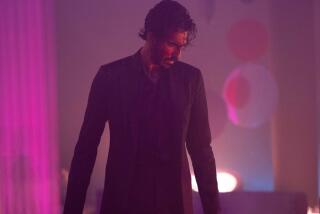Review: Satyajit Ray’s Apu trilogy is restored and screening again
As studio tent-pole movies trample multiplexes this summer, cinema’s wondrous human-sized trilogy returns: the gorgeous, 4K (high-resolution) restoration of legendary Indian filmmaker Satyajit Ray’s Apu films from the 1950s, “Pather Panchali” (Song of the Little Road), “Aparajito” (The Unvanquished) and “Apur Sansar” (The World of Apu).
A graphic artist and writer, Ray admired Italian neorealism, and it fueled his desire to find a different approach to Indian film narrative. Adapting a pair of novels about a Bengali boy from a poor village and his maturation as a student and writer, then as a husband and father, Ray established himself on the world stage as a master of eloquent images, storytelling grace and empathy that courses like a river.
After its triumphant showing at the 1956 Cannes Film Festival, “Pather Panchali” was awarded the festival’s first prize for best human document. That’s a dry-sounding award, but it befits a moviegoing experience so rich with insight into what binds us all as people struggling on this Earth.
“Pather,” Ray’s debut, shot in increments over years and poetically visualized to a fault, fairly brims with the seesawing rhythms of poverty-stricken rural living.
“There are always good times and bad,” Apu’s optimistic father (Kanu Banerjee) says during a rare extended stay at their crumbling home between job foraging. Judging, however, from the anguish that is mother’s default expression — she’s the one living the consequences of their debt and low status — it’s always the latter. (Karuna Banerjee’s performance, a poignant fermata of worried gazes and exhalations, is marvelous.)
Meanwhile, Apu (Subir Banerjee) and his older sister (Uma Das Gupta) stand their ground as children as long as they can — open, observant, innocent (till proved guilty, in the case of sister’s stealing). If ever a movie could claim to be spirited and sad in pitch-perfectly equal measure, it’s “Pather Panchali.”
That’s thanks in no small part to the tactile black-and-white cinematography of Subrata Mitra, who’d been a still photographer before filming, and to the deftly timed ragas of Ravi Shankar. The music is among the all-time great scores and seems to erupt straight from the characters’ souls. Mitra and Shankar would collaborate with Ray on the follow-ups as well.
In “Aparajito” (1956), Apu (Pinaki Sengupta and Smaran Ghosal) hits adolescence and leaves home to become a student in Kolkata, complicating his relationship with his mother. Here, Ray sharpened his instinct for visual expressions of reflection and solitude, even as the characters move from place to place, constantly adjusting and readjusting their sense of home and family.
With “Apur Sansar” (1959), filmed after Ray directed two features outside the trilogy, Ray’s alchemy of image, sound and emotion is so substantial that it unfolds like a novel whose pages turn themselves. This last installment explores love, misfortune and responsibility with an enveloping compassion and intelligence, anchored by hard-to-forget performances from nascent Ray regulars Soumitra Chatterjee as grown-up Apu, trying to make his way as a writer, and Sharmila Tagore as the bride with whom he stumbles into marriage.
The final scene is justly considered one of film’s greatest, set on a road, in the space between a father and son, between childhood and adulthood. It’s not only immensely moving but like seeing art and life in the warmest, most meaningful of embraces.
------------
‘The Apu Trilogy’
MPAA rating: None
Running times: “Pather Panchali,” 2 hours, 5 minutes; “Aparajito,” 1 hour, 49 minutes; “Apur Sansar,” 1 hour, 45 minutes
Playing: Nuart, West L.A.
More to Read
Only good movies
Get the Indie Focus newsletter, Mark Olsen's weekly guide to the world of cinema.
You may occasionally receive promotional content from the Los Angeles Times.






